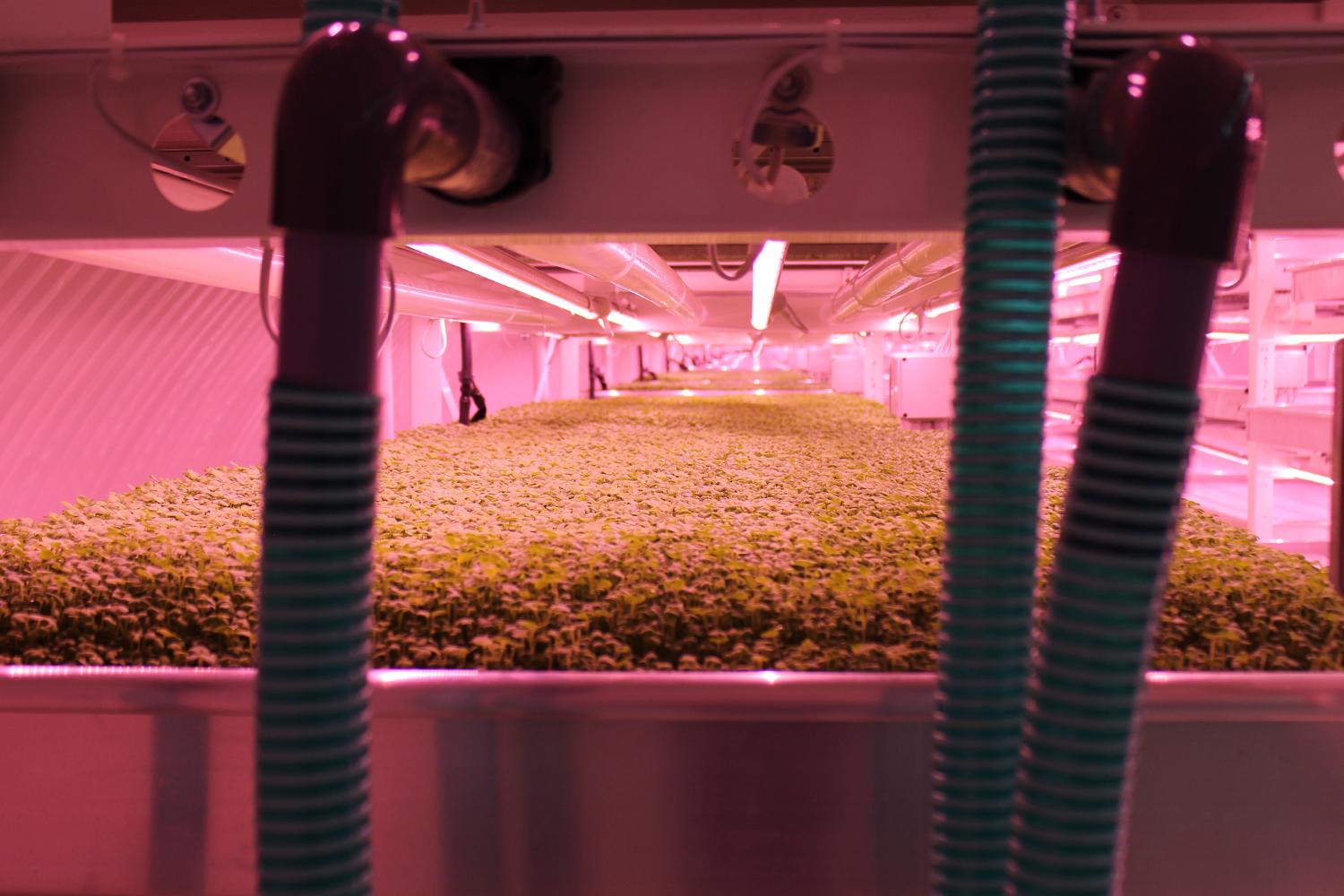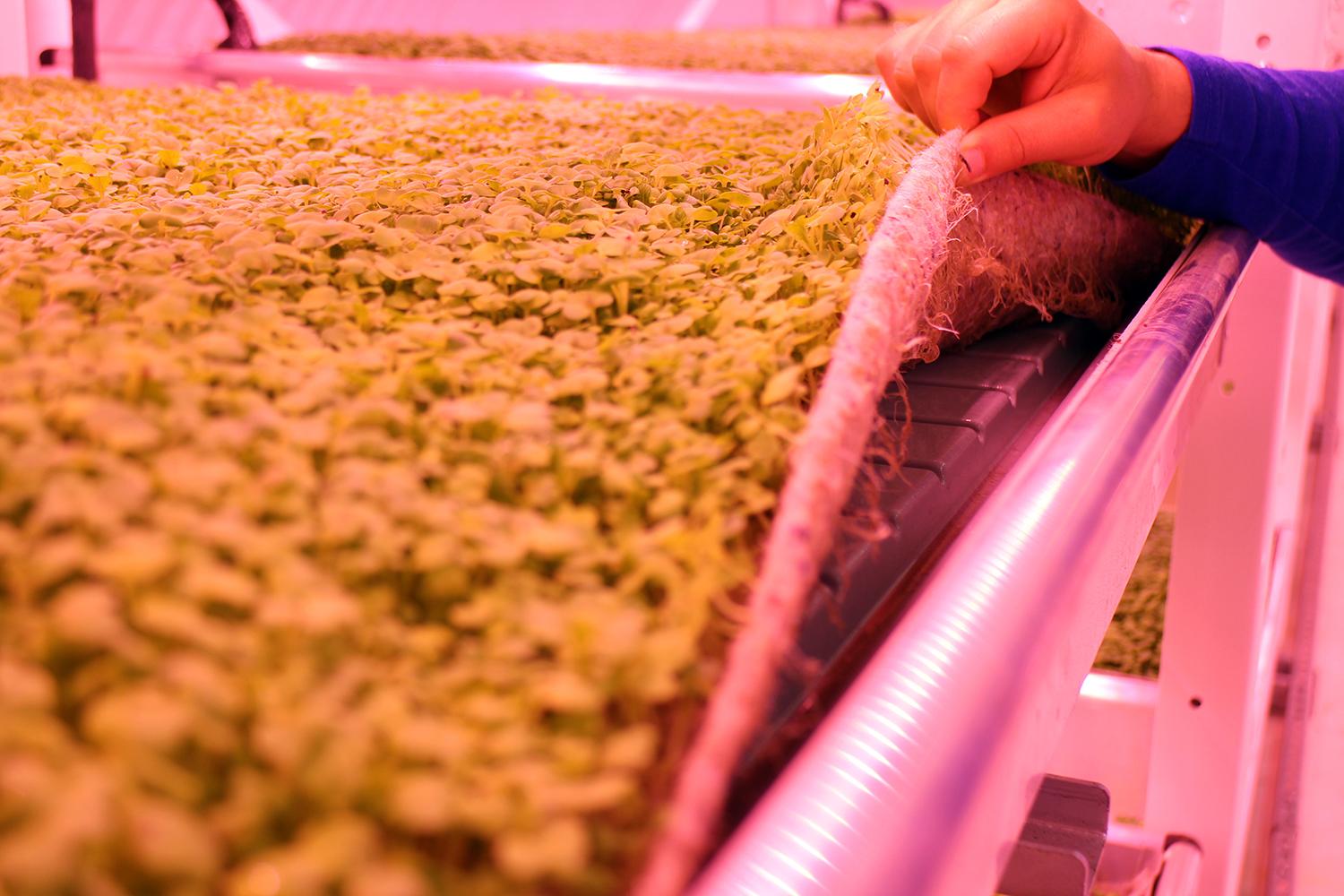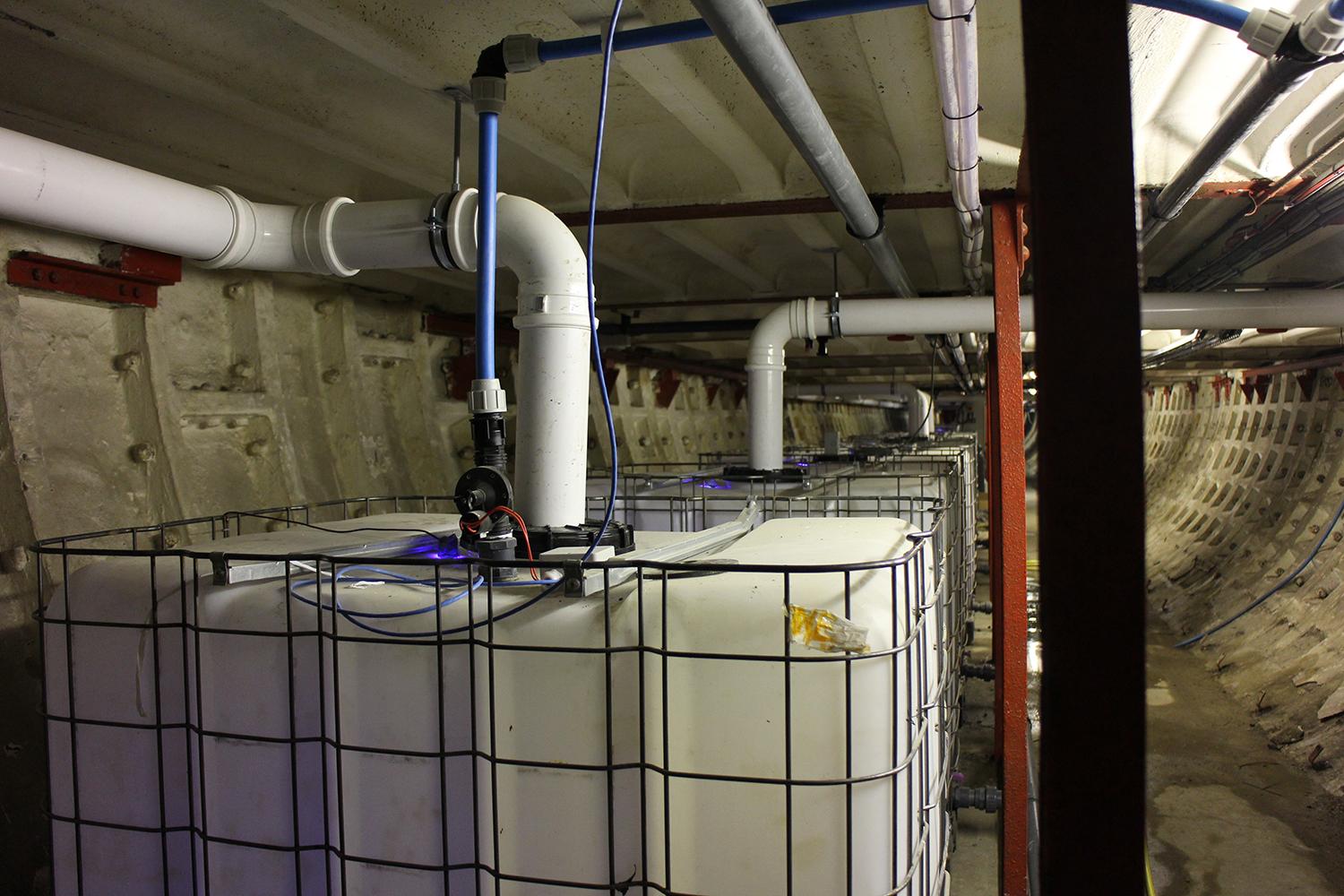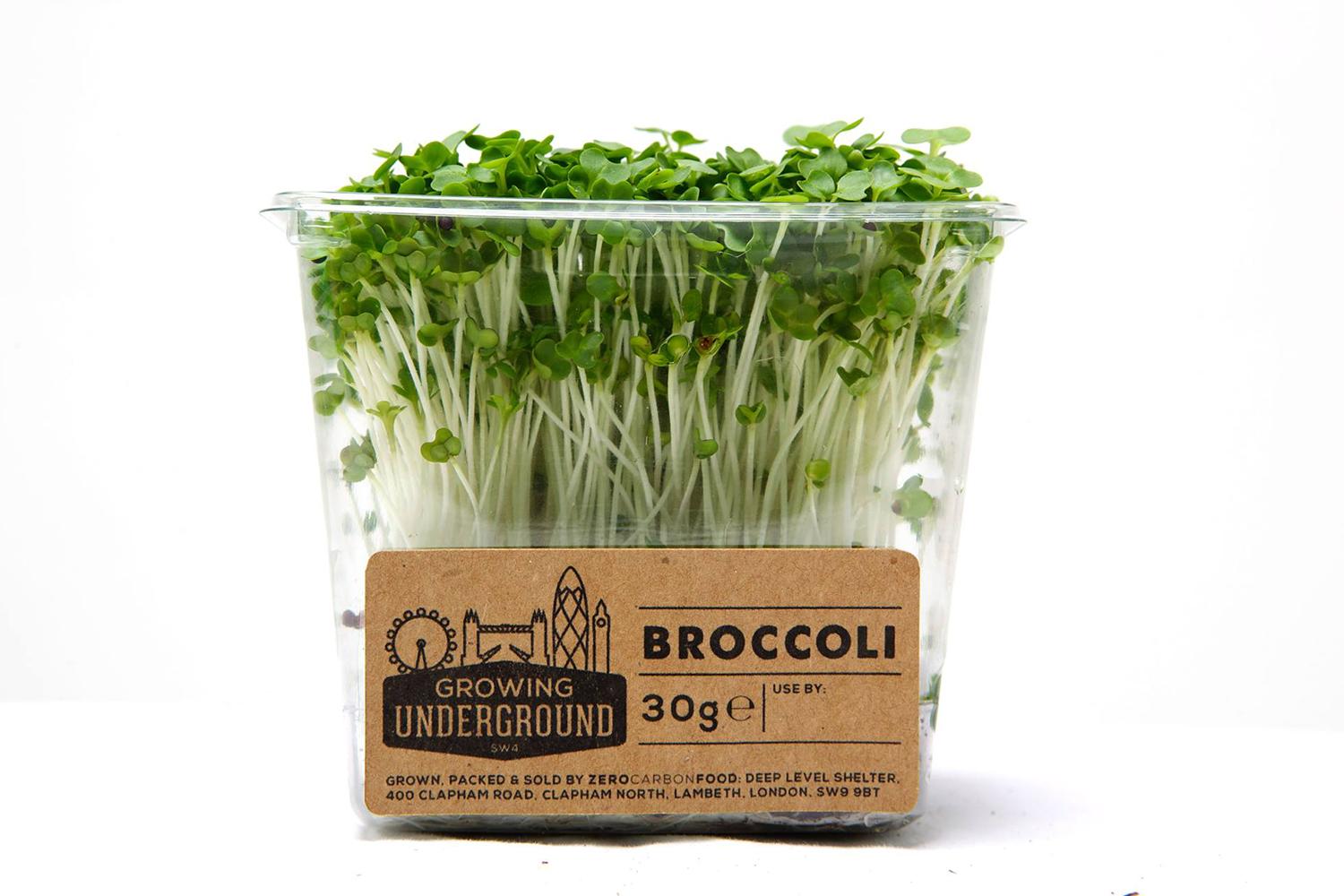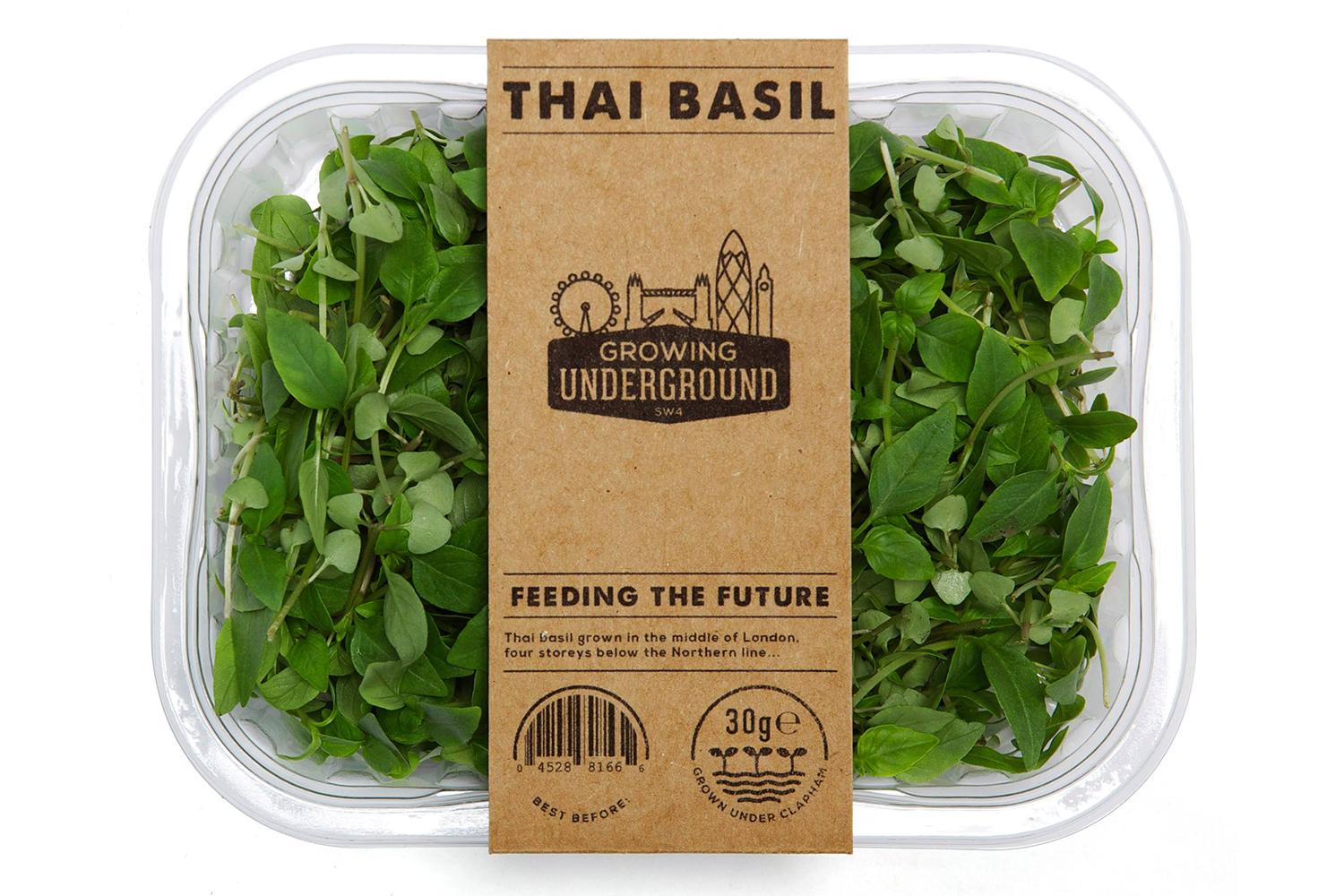
“The population is growing, demand for food will only increase, and we’re running out of farm land. We think finding alternatives that make the best use of unused land is the future.”
When you imagine visiting a farm, pictures of rolling countrysides, tractors, barns, and sunny skies pop into your head. Old mineshaft-like industrial elevators do not, but for my farm visit, one was essential. Why? Because this farm is located 11 stories, or about 33 meters (108 feet) below the streets of London.
Growing Underground is the world’s first underground eco-farm and there isn’t a tractor in sight. Instead, it’s a cross between the sci-fi movie Silent Running and the public’s idea of what an illicit cannabis growing operation probably looks like. The place has built in air raid tunnels from the 1940s that once held bunk beds for up up to 8,000 people. Today, a different kind of bed lines the tunnel walls.
Stacked, 2×1-meter trays house a variety of micro herbs, from mustard to pea shoots, all of which are grown in a tightly controlled, completely artificial environment. Aside from the herbs, and the small Growing Underground team, nothing else fills the tunnels. No rats, no moles, not even spiders. Before the farm took up residence, data storage companies used it to house paper files. Threats of terrorism, and fear of a locked down city, have seen data storers move — rather ironically — out into the countryside.
Mass agriculture is damaging the environment
Deep under the city is the last place you’d expect to find a farm, but the argument for putting one there is compelling. Steven Dring, who looks after the business side of the farm, said “The population is growing, demand for food will only increase, and we’re running out of farm land. Mass agriculture has a big impact on the environment. We think finding alternatives that make the best use of unused land, and not ripping down rain forests, is the future.”
Richard Ballard, co-founder of Growing Underground, explained how he came across the tunnels quite by accident, after conducting research on a documentary about hidden London. Starting an underground eco-farm was the furthest thing from his mind at first, but it turns out, an underground farm not only has a tiny impact on the environment, it is also ideally suited to growing certain crops and shockingly cost effective. One square foot of tunnel space costs little more than £1 ($1.55), while above ground at central London rates, that same plot could cost up to £130 ($201.05) per square foot.
Once I descended to the depths, I was shown around the tunnels. They stretch for more than 500 meters (1,640 feet), the atmosphere stays at a constant 50-degrees, and the air has a distinct taste to it. It’s not unpleasant, nor dusty, and there is natural ventilation throughout; but the air’s density makes you very aware of the unusual surroundings. Large fans keep the air circulating, an essential piece of the puzzle for growing crops deep underground.
A sci-fi environment with considerable future implications
Without trying, the team has created something straight out of a post-apocalyptic sci-fi movie. The tunnels seem to go on for miles; the futuristic pink, white, and blue LED lighting bathes everything in bright light; and the feeling of isolation is uncanny. Trains running along the nearby London Underground tunnels rumble their way past, providing a vibration you feel through your feet, and a bass throng you feel in your stomach. If you didn’t know, it could be the machines waging war on the surface. I bet those hiding from the Blitz may have felt something similar.
“Four years ago, from a technical standpoint, none of this was possible.”
It’s a considerable technical challenge to maintain a farm that’s completely removed from the sun, water, and moving air. The solution is to use existing agri-tech products in unconventional ways. Strips of custom LED lights replace the sun, and are mounted a set height above the crops. After testing five different versions, models from a Finnish manufacturer were chosen. Surprisingly, the lights can affect the taste of the growing crops, as can tweaking the spectrum of light produced, Chris Nelson, co-founder and horticultural expert told me. “Four years ago, from a technical standpoint, none of this was possible,” he said.
The farm isn’t connected to the main water supply, and instead uses huge water tanks and a custom built irrigation system to water the crops. Each tank is bathed in blue LED light, and banked by blinking red indicator lamps. The steel walls curve over the top, valves and timers scatter the floor, and a tangled framework of pipes send the water to plastic tubes that run across the top of the growing benches. The water is recycled, cleaned, and checked before going round again. Fertilizer and and an antibacterial treatment is used, and the whole system only occasionally needs a top up.
While the water and artificial sun are cheap to maintain once up and running, they both require electricity, which is the farm’s biggest cost, and one which it needs to get from the world upstairs. Growing Underground takes its power from Green Energy, which provides clean power from wind and water. The temperature is raised and controlled to around 21 degrees Celsius (70 degrees Fahrenheit), mainly through recovered heat produced by the LED lights.
Going from the brightly lit linking tunnels to the vivid pink growing room, then the alarming total darkness of the water pump room with only the din from the water pumps for company; it was, again, easy to imagine being aboard a spacecraft. I asked if a farm like this could, theoretically, be used by astronauts or on other planets. The answer is yes, because the entire farm is almost completely self contained. In fact, not only could it be used in space, but also in a submarine, or stored in a crate and buried beneath the desert. All the while still consistently producing fresh food.
Micro herbs are just the start
How much food, and what kind, you ask? At the moment, Growing Underground produces 10 different micro herbs, which will be sold to traders at the New Covent Garden Market before ultimately gracing the dishes made by chefs at many of London’s best and biggest restaurants. The hospitality trade is the target at the moment, but consumers could be catered for in the future. The crops have been chosen because demand is high, and outstrips what the farm can currently produce.
Once built to protect the city’s population during war, the tunnels are being given an entirely new and exciting life.
Take mustard, as an example. It’s about seven days between planting and harvesting, and the farm can produce 700 wholesale cases each day, seven days a week, 365 days per year. That’s using the 90 meters (295 feet) of beds that are currently operational. The maximum size of the facility is more than 540 meters (1772 feet). There are no seasons, it’s never too hot or too wet, the days start when the team wants — it’s ‘day’ is between midnight and 6 p.m. in the farm at the moment, to take advantage of cheaper energy rates — and the results taste the same, if not better than anything grown on the surface. It’s fresher too, because the mustard is seeded and harvested once each day, and reaches the market in a matter of hours, not days. Eating some straight from the growing bed, it tasted pretty good to me.
The 10 herbs are just the start. The capacity is there for hundreds of varieties, and the farm could expand to grow anything from micro vegetables, edible flowers, super foods, or plants that are used for medicinal purposes. Growing Underground will officially begin production, and start selling produce, by August. At this time the growing rooms will be isolated, and visitors will need to wear special clothing to enter. It’ll be less like visiting Zion from the Matrix, and more like hanging out on the Discovery One from 2001: A Space Odyssey.
Emerging back out onto the streets of Clapham, south London, after my tour concluded made the Growing Underground farm’s existence seem almost impossible. It’s surreal that next time you dine out in London, there’s a chance the herbs that complete each dish originated in tunnels dozens of meters below the streets.
Once built to protect the city’s population during war, and after storing bits of paper for years, the tunnels have an entirely new and exciting life. It’s one that’s fuelled by innovation and environmental concern, and made possible by creative use of modern technology. While diners at expensive restaurants will get the benefits for now, the implications of the Growing Underground project — a self-contained, zero-emission, fully working farm that can operate almost anywhere on or off the planet — are tremendously exciting.






